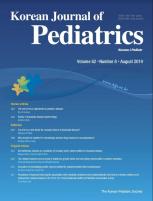Kawasaki disease (KD) is a systemic vasculitis leading to coronary artery lesions (CAL), the most common cause of acquired heart disease in children in developed countries.
White blood cell count, polymorphonuclear leukocytes, hemoglobin, C-reactive protein (CRP), erythrocyte sedimentation rate, albumin, aspartate aminotransferase, alanine aminotransferase, total bilirubin, sodium, platelet count, N-terminal pro-brain natriuretic peptide, interleukin-6 (IL-6), and IL-10 are effective laboratory predictors for intravenous immunoglobulin (IVIG) resistance and CAL in KD patients [1,2]. The initial administration of IVIG ≤ 4.0 days after symptom onset, oral mucosa alterations, cervical lymphadenopathy, and swelling of the extremities are known clinical predictors of IVIG resistance [1].
Anemia commonly occurs in KD patients despite normochromic and normocytic status. The mechanism of anemia in KD is prolonged active inflammation; however, its correlation with iron deficiency is uncertain. Iron deficiency can occur as an absolute and/or functional deficiency [3]. Anemia of inflammation (AI) is the ultimate consequence of these functional disturbances of iron homeostasis and can be seen in cases of acute and chronic infections, inflammatory disorders, and malignancies. Combined forms of iron deficiency anemia (IDA) and AI are typically observed in patients with inflammatory bowel disease (IBD) or gastrointestinal or urogenital malignancies. Anticoagulant or antiplatelet drugs may contribute to iron loss in chronic kidney disease and other chronic diseases [3].
The activation of immune cells by infectious agents and auto-antigens initiates and maintains the development of AI by several mechanisms. The excessive production of inflammatory mediators diverts iron to the mononuclear phagocyte system (MPS), rendering it relatively unavailable for erythroid progenitors. Hepcidin antimicrobial peptide (HAMP) is the hormonal negative-feedback regulator of serum iron that limits iron fluxes to the circulation. Increased HAMP levels have been documented in infections, rheumatoid disorders, and IBD in contrast to suppressed levels in IDA. HAMP concentration positively correlates with the extent of inflammation, in relation to iron sequestration in the MPS. In AI, inflammatory markers such as CRP or IL-6 must be considered with altered serum ferritin production and levels [3]. Hyperferritinemia (>200 ng/mL) with decreased transferrin saturation is indicative of AI [3].
Hepcidin controls iron metabolism and the pathogenesis of AI [4]. Increased hepcidin levels are correlated with the development of anemia and disease outcomes in patients with KD [5]. Huang et al. [6] reported that hepcidin induces transient anemia and hypoferremia during the acute inflammatory phase of KD. In this study, the hemoglobin levels were lower in pre-IVIG patients than controls and continued to decrease after IVIG treatment. Both the plasma iron levels and total iron-binding capacity (TIBC) were lower in patients with pre- and post-IVIG treatment. The transferrin saturation (iron/TIBC) was lowest prior to IVIG treatment. Several studies have reported that inflammation-induced hepcidin can induce transient anemia and hypoferremia in the acute phase of KD. KD patients often present with hepatitis and jaundice; since hepcidin is produced mainly in hepatocytes, modified hepcidin expression can occur in KD [6]. Thus, hepcidin may be helpful in the differential diagnosis of anemias since it is suppressed in IDA and elevated in AI.
There is increasing evidence that iron status is associated with coronary artery disease and vasculitis. In the study in this issue [7], the authors reported that iron deficiency can predict CAL development in KD. Anemia, iron deficiency, and IDA were significantly associated with CAL compared to other clinical and laboratory predictive findings of CAL. The authors reported that a low ferritin level was highly associated with CAL.
Assuming that the KD patient had already developed IDA, this finding implies that breastfed infants are at higher risk of developing KD than bottle-fed infants, but evidence of this is lacking. Therefore, iron deficiency in high-risk KD patients may be caused by functional iron deficiency of inflammation rather than absolute iron deficiency. In another study, serum ferritin level was significantly elevated (≥165 ng/mL) in nonresponders, a finding that is in contrast to that reported in the current study. The authors of that study found that many nonresponders to IVIG with low-risk scores had high serum ferritin levels [8].
Before iron or hepcidin can be considered treatment options, further studies including serum hepcidin level as well as hemoglobin and iron indices may be helpful to identify risk factors for CAL among KD patients.





 PDF Links
PDF Links PubReader
PubReader ePub Link
ePub Link PubMed
PubMed Download Citation
Download Citation


